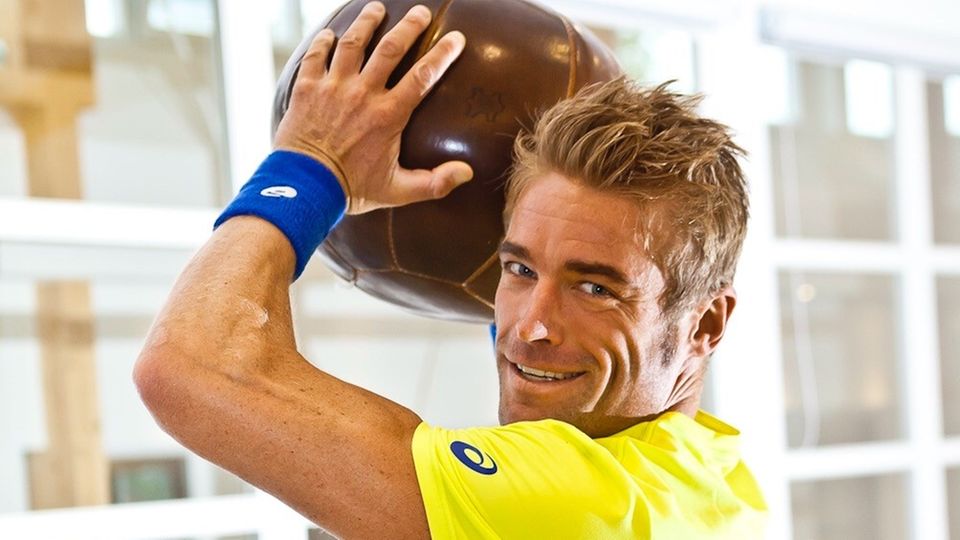Fitness at home
Kettlebell Workout: What you need to know about training with kettlebells
If you don’t have room for a weight bench and pull-up bar at home, you should think about kettlebells. The weights with handles are true fitness all-rounders. With personal coach Maximilian Longrée, we clarify the most important questions about smart kettlebells.
In 2019, almost twelve million Germans were active (or at least paying members) in one of the approximately 10,000 fitness studios or fitness clubs. The trend is increasing. The corona pandemic slowed down the positive development of doing more for your body. According to Statista, there are currently only around 9.3 million people registered in a fitness studio (as of January 2023). This is annoying for the operators. But the pandemic also had something good: for many people, fitness and strength training has shifted to the living room at home or the hobby room. One of the most versatile tools for at least maintaining your fitness level are (and will remain so even after the Corona period) kettlebells.
In this article we clarify the most important questions about practical dumbbells with handles. The basics on the topic and all the exercise examples come from the textbook . Here you can find the book author and personal coach consequences.
What exactly are kettlebells?
Like many other fitness tools, the kettlebell trend flew across the pond to the gyms of Europe. The weights with handles probably originated in Russia in the 18th century. Back then, circus artists performed daring tricks with the round dumbbells, letting them fly through the air and flexing their muscles. Kettlebells have now become an integral part of weight training worldwide. Along with barbells and dumbbells, they are part of the basic equipment of every fitness studio with an area for free training. There they are sorted by weight – the lightest are 2 kilograms, the heavyweights weigh an impressive 40 kilos. In between, fitness fans can find almost everything their heart desires and their body is capable of. .
Which muscles are trained with kettlebells?
Kettlebells are one of the most versatile fitness tools out there. When used correctly, individual muscles, entire muscle groups and muscle chains can be specifically trained. Kettlebell workouts also improve strength endurance, mobility, speed and coordination. In short: If you work with kettlebells regularly and correctly, you train your entire body. The amazing thing is that at least seven muscle chains are required with just one movement sequence, namely the typical kettlebell swing movement. In addition to the calf muscles, these include the thigh flexors and extensors, the hips, the abdominal muscles as well as the gluteus muscles and the back extensors.
Kettlebell Workout: Which is the right weight?
False ambition is out of place in kettlebell training – as in most sporting challenges. However, there is no rule of thumb for finding the right weight for each individual. Beginners in particular should therefore start with smaller kettlebells. You can always top up later. Women who try kettlebell training for the first time initially use 6-pound balls. For men, the recommended starting weight is twelve to 16 kilograms. If you have been training your muscles in the gym for a while, you can start with eight kilograms (women) and 20 kilograms (men). The increase is then only made after four to six weeks at the earliest – in increments of two or four kilograms.
If you have limited space or don’t feel like storing half a dozen kettlebells in your apartment, you should think about adjustable kettlebells. At the Six weights between 3.5 and 18 kilograms can be adjusted using the rotary wheel.
You want more about Fitness equipment at home experience? Here are tips and tricks from Ironman winner and personal coach Maximilian Longrée.
Iron or sand: which kettlebell is the right one?
Ten kilograms is ten kilograms. The famous joke about the feathers and the iron is probably well known. Basically, the question about the material of the kettlebell is more about where you train with the dumbbell. Gyms usually have a special floor that can withstand an iron ball that lands roughly. Things usually look different in a rented apartment. So if you don’t necessarily want to train with bare iron, it’s best to use a material version filled with sand, for example is. This not only protects the laminate or tiles, but also the nerves of the subtenants. A good compromise are kettlebells with a neoprene cover or a textile cover. A variant of this is .
What exercises should kettlebell beginners start with?
When it comes to kettlebell workouts, you first have to familiarize yourself with the new training device and gain experience of success. Anyone who goes all out doesn’t just risk injuries. If you don’t succeed in demanding exercises straight away, there is also a risk that beginners will quickly lose interest. Here are two popular exercises that will get beginners wanting more.
- Deadlift | A classic from strength training. The starting position is upright; feet are hip-width apart; the kettlebell is right in between. Now push your bottom back and lift the kettlebell a few centimeters with both hands and a straight back. Then slowly stand up and bend back down with your back straight. The weight does not touch the floor. Beginners should start with 10-16 repetitions per set. There doesn’t have to be more than three sets with breaks of one minute each to start with. In addition to the back muscles, deadlifts also train the buttocks and shoulder muscles,
- Swing with both arms | Probably the most famous of all kettlebell exercises. The starting position is to stand slightly more than hip-width apart, with the tips of your feet pointing slightly outwards. Now bend your knees slightly and grab the kettlebell with both hands with your upper body bent. Important: Keep your back straight. Now the kettlebell is swung with an explosive movement from the hips and with the gluteal muscles maximally tense until it is approximately at eye level. The strength should not come from the arms or shoulders, but only through hip extension. As you swing down, your arms remain stretched. The bottom only goes back when the upper arms touch the upper body during the backswing. Here too, three sets of 10-16 repetitions are perfect to get started.
The exercise examples and basics on kettlebell workouts come from the book “Faster with Strength Training” by Maximilian Longrée.
For further exercises and tips for your first kettlebell workout, handy training cards with exercise descriptions in text and images are also suitable. A selection of 50 exercises is available available here.
Sources: “Faster with strength training” (by )
* There is more information about this .
Source: Stern
I am Pierce Boyd, a driven and ambitious professional working in the news industry. I have been writing for 24 Hours Worlds for over five years, specializing in sports section coverage. During my tenure at the publication, I have built an impressive portfolio of articles that has earned me a reputation as an experienced journalist and content creator.




